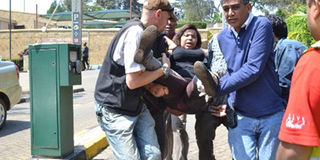All missing people traced, says Kenya Red Cross

Some volunteers helping an injured woman after she was shot at Westgate mall by terrorist during the standoff that started on September 21, 2013. FILE PHOTO |
What you need to know:
- The Oshwals — a group that follows the Jainism religion and traces its roots to India — meet for religious, cultural and social activities and were at the Oshwal Center on September 21, 2013, preparing for a religious event scheduled for the following day.
- The missing-persons list that had been generated by the Kenya Red Cross has not been made available to the media and Mr Gullet, the secretary-general, said the list was reconciled.
Families and friends who had reported their loved ones as missing after the Westgate Mall terrorist attack last year found them either dead or alive.
This is according to the Kenya Red Cross, which was responsible for recording data on people reported as missing.
Secretary-General Abbas Gullet on Thursday told Nation.co.ke that the numbers of the Westgate missing list had been verified.
“We reconciled the numbers of the people who were reported as missing, and as of now there are no more missing people,” he added.
The last figure of missing people reported by the media stood at 36, after some people reported missing were found alive and six more bodies were retrieved from the rubble by the security forces.
According to Rashmi Shah, the chairman of the Visa Oshwal Community, all Asians reported missing had been traced. Oshwal members volunteered and opened up their centre, which was metres away from the mall, to the victims.
“No people are still missing, either among the Visa Oshwal Community or even in the larger Asian community, as we traced all people and cremated those who died in the attack while those injured are still recovering,” he added.
The Oshwals — a group that follows the Jainism religion and traces its roots to India — meet for religious, cultural and social activities and were at the Oshwal Center on September 21, 2013, preparing for a religious event scheduled for the following day.
But, after the siege began that Saturday afternoon, the centre became a safe haven for hundreds of victims from all walks of life, as the centre set up a camp to give them the much needed help.
OPENED GATES
Reports came to them at around 12.45pm that there was shooting going on at the mall, and Mr Shah advised those present that the centre’s gates be closed for their own protection.
But they kept hearing sustained gunfire and soon found out that what was going on at the mall was likely a terrorist attack. At 2.30pm, a crowd started gathering outside the Oshwal gate.
“We thought they were curious members of the public, then a security guard came and told me that the individuals had come from Westgate and they wanted to enter ,” said Mr Shah.
So Mr Shah advised the guard to open the gate. Some of the people seeking shelter had minor injuries while others were traumatised by what they termed a horrible shootout.
“At that stage, the gates were open for everybody: black, brown and white. This was on humanitarian grounds,” he said.
The Oshwals present became volunteers and soon other members of Kenya’s South Asian community arrived to lend a hand.
“We started treating the wounded, listening to them, giving them food and water, charged their phones and had them use ours to contact their relatives,” said Mr Shah.
Throughout the four days of the siege, the centre was open to all and the Kenya Red Cross set up counselling and missing-person’s desks there.
“We were not directly involved in coming up with the missing-people list or even the tracing of them, though the Red Cross was operating from our centre,” Mr Shah said.
The missing-persons list that had been generated by the Kenya Red Cross has not been made available to the media and Mr Gullet, the secretary-general, said the list was reconciled.





